MARIANI’S
Virtual
Gourmet
December
24, 2017
NEWSLETTER
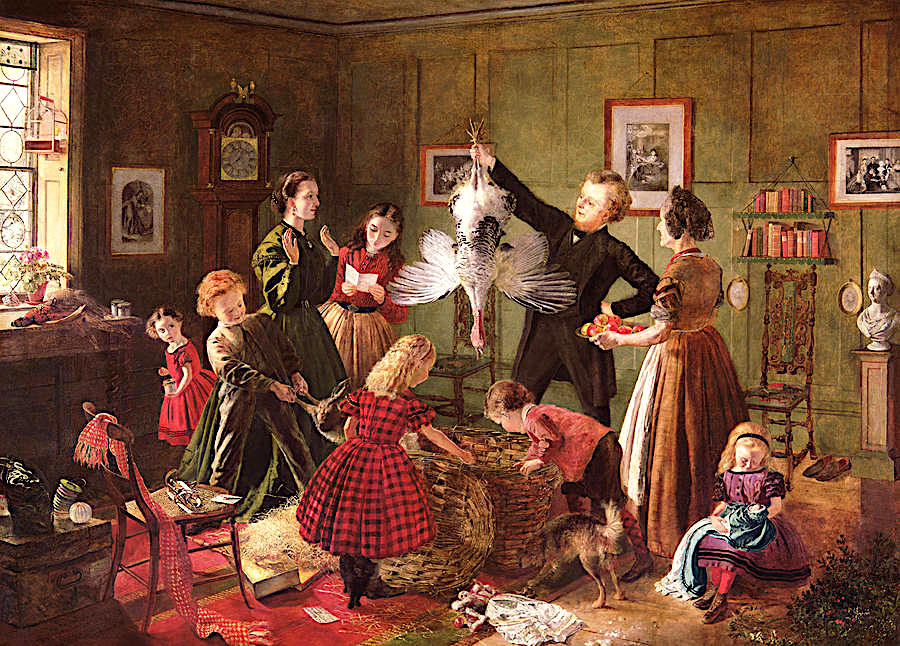
IN THIS ISSUE
PARIS DINING
By John Mariani
NEW YORK CORNER
THE GRILL
By John Mariani
NOTES FROM THE WINE CELLAR
MERLOT MOVES UP IN FAVOR
By Brian Freedman
❖❖❖
 A GREAT
CHRISTMAS GIFT
A GREAT
CHRISTMAS GIFTThe Hound in Heaven (21st Century Lion Books) is a novella, and for anyone who loves dogs, Christmas, romance, inspiration, even the supernatural, I hope you'll find this to be a treasured favorite. The story concerns how, after a New England teacher, his wife and their two daughters adopt a stray puppy found in their barn in northern Maine, their lives seem full of promise. But when tragedy strikes, their wonderful dog Lazarus and the spirit of Christmas are the only things that may bring his master back from the edge of despair.
WATCH THE VIDEO!
❖❖❖
PARIS DINING
By John Mariani
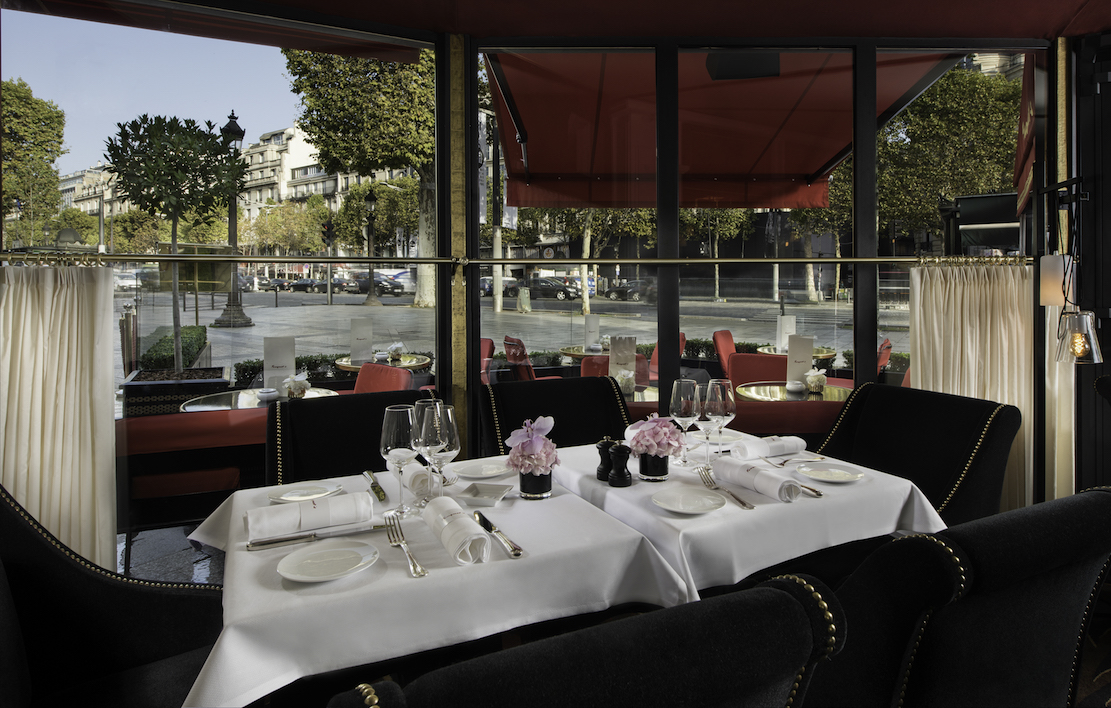
The Brasserie Terrace at Fouquet's Paris on the Champs Élysees
One of Oscar Wilde’s characters observed, “When good Americans die, they go to Paris.” Which is sufficient reason for me to try to be one, for, if I must spend an eternity somewhere, I doubt I’d ever run out of things to see, hear, do or taste in Paris. Indeed, it always strikes me that bad Americans who go to Paris and restrict their diet are like people who go to the movies and don’t buy popcorn. It’s really absurd.
Meanwhile, I try to pack as much time on earth into visits to Paris and to dine from the top, where the cuisine can be sublime, to the bottom, where the food is usually wonderful, but not always. Two trips this year gave further proof of that, as well as to the proposition that you can get a bad meal in Paris, including at Alain Ducasse’s dreadful new Champeaux, set within the maze of modern banality that was once scruffy Les Halles. The restaurant looks like a cafeteria, the menu is a complete bore, and the food seems slung onto the plate from some assembly line.
But enough of that.
FOUQUET’S Paris
Hôtel Barrière Le Fouquet’s Paris
46 Avenue George V
+33 1-4069-6000
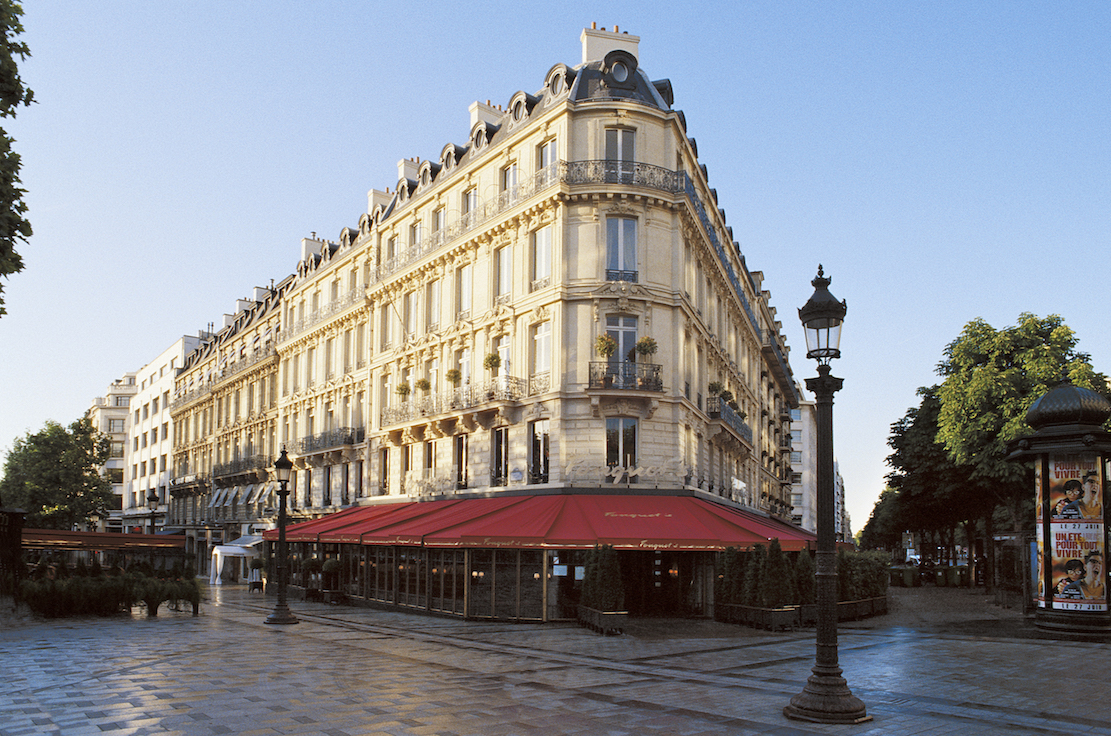 For
lunch,
I chose a favorite venue from which my wife and I
could watch the flow of Parisians and visitors
walk slowly up and down the Champs Élysées, which
always includes a line of Japanese women exiting
the Louis Vuitton flagship store across the
street.
For
lunch,
I chose a favorite venue from which my wife and I
could watch the flow of Parisians and visitors
walk slowly up and down the Champs Élysées, which
always includes a line of Japanese women exiting
the Louis Vuitton flagship store across the
street.
Fouquet’s Paris began in 1899, named after its
owner, Louis Fouquet, who sought to attract
well-to-do American tourists and knew the value of
advertising “American Drinks & Cocktails.”
The restaurant survived two
World Wars, the Depression, changing fashions,
persnickety landlords and, in the 1970s, a fading
of the Champs Élysée’s chic. A new owner, Maurice
Casanova, in 1976 added the identifying red and
gold awnings, which now seem as much a part of the
revived boulevard as any landmark in Paris. Now,
since 2006 attached to the 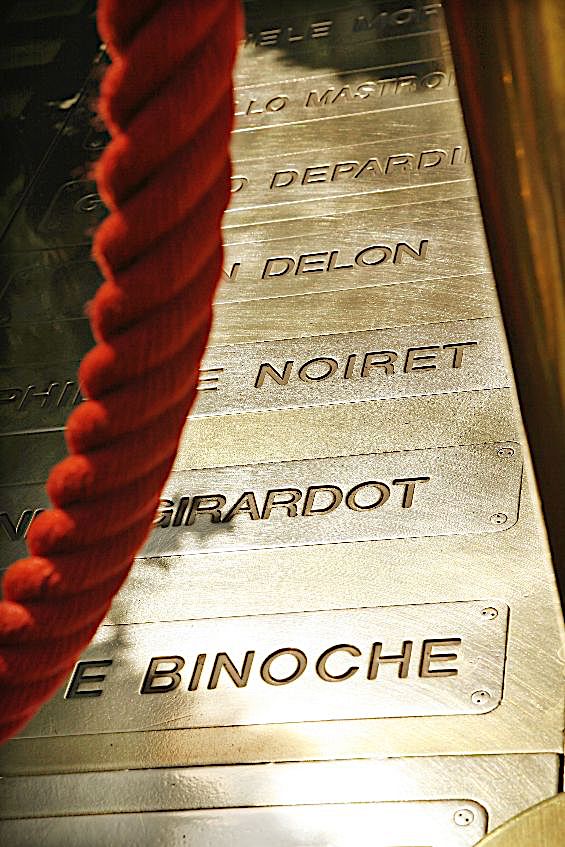 Hôtel Barrière,
everything at Fouquet’s has undergone a total
restoration, and Chef Pierre Gagnaire has been
brought on to oversee the contemporary menus.
Hôtel Barrière,
everything at Fouquet’s has undergone a total
restoration, and Chef Pierre Gagnaire has been
brought on to oversee the contemporary menus.
An overcast day—pretty much a given in Paris in late October—did nothing to dampen our spirits at our table, though two cigar smokers did.
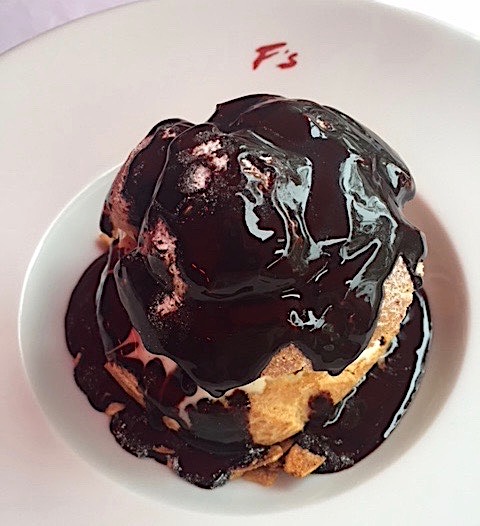 For
40
years Fouquet’s Paris has been host to the after
party of the César film awards, so the interior
dining room’s walls are lined with photos of
actors and actresses, while just outside the
restaurant a bronze plaque (right) in the
ground lists many of the winners of the award.
For
40
years Fouquet’s Paris has been host to the after
party of the César film awards, so the interior
dining room’s walls are lined with photos of
actors and actresses, while just outside the
restaurant a bronze plaque (right) in the
ground lists many of the winners of the award.
The menu remains classic, with some modern flourishes. We began with a light lentil salad with poached egg and saucission (right), and I could hardly help ordering the onion soup au gratin, but I was disappointed because the soup’s cheese was not properly melted and its onions were only lightly caramelized. Gagnaire’s input can be seen in novel dishes like sea scallops in coconut milk, and lobster ravioli in a foamy Nantua-like sauce. For dessert, the traditional profiterole (left) is not bettered by any in Paris.
Our chilled bottle of rosé
reminded me that, as the song says, “I love Paris
in the winter, when it drizzles.” And looking up
the slight incline of the Champs Élysées towards
the Arc de Triomphe, I almost imagined seeing
Anouk Aimée in the middle of the street and
hearing that lovely lilting music from the film A
Man and a Woman.
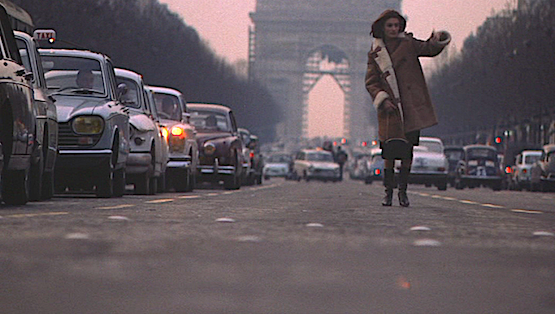
LE BAR DES PRÉS
25 Rue du Dragon
+33 (0) 623 74 30 55
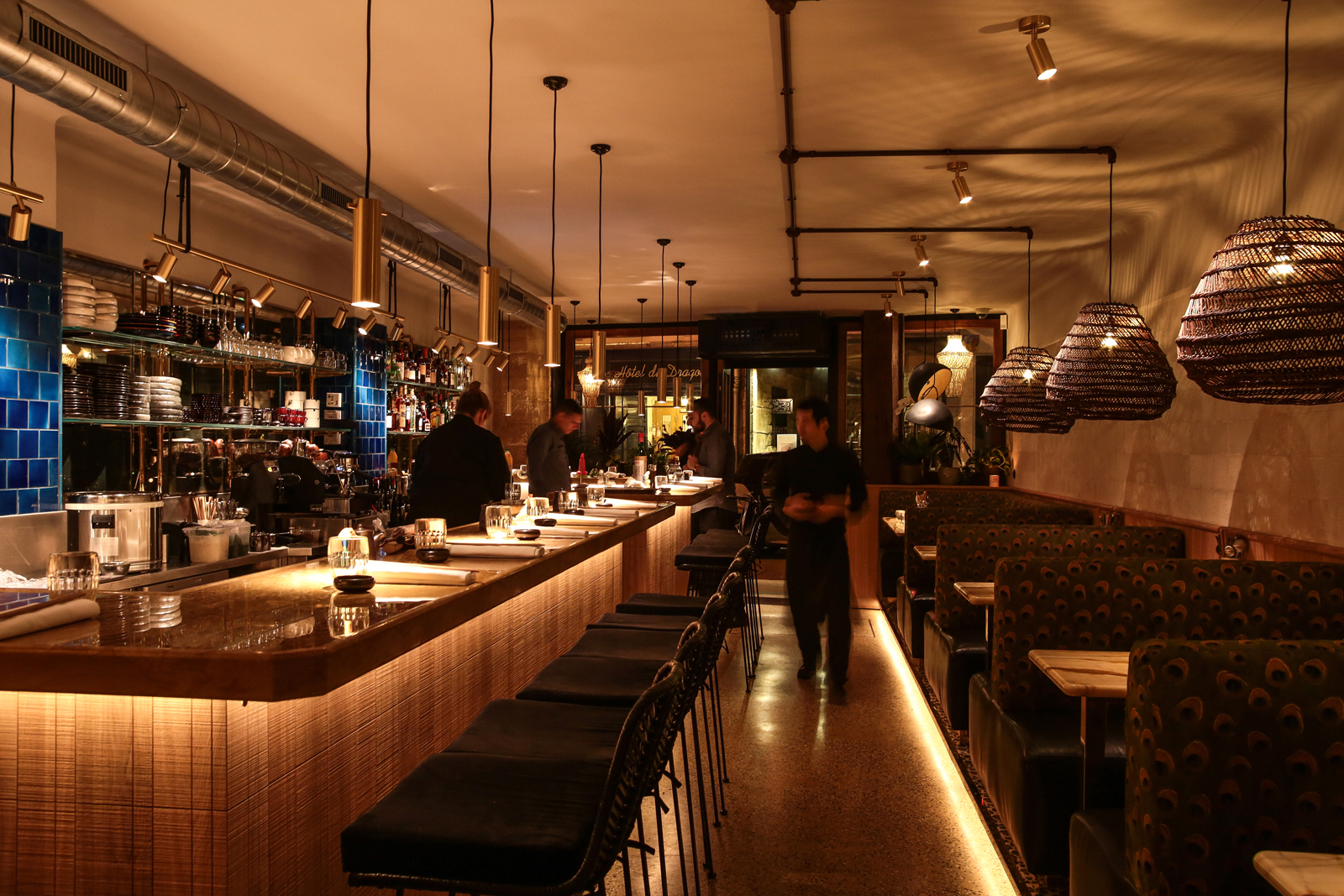 On
arriving in Paris this fall, my wife and I were in
the mood for something new, so we headed to Cyril
Lignac’s delightful year-old Le Bar des Prés,
which is right next door to his two-year old
modern bistro, Aux Pres. I’ve long admired
Lignac’s cuisine at his upscale Le Quinzieme, and
this new place expands upon his interest in
On
arriving in Paris this fall, my wife and I were in
the mood for something new, so we headed to Cyril
Lignac’s delightful year-old Le Bar des Prés,
which is right next door to his two-year old
modern bistro, Aux Pres. I’ve long admired
Lignac’s cuisine at his upscale Le Quinzieme, and
this new place expands upon his interest in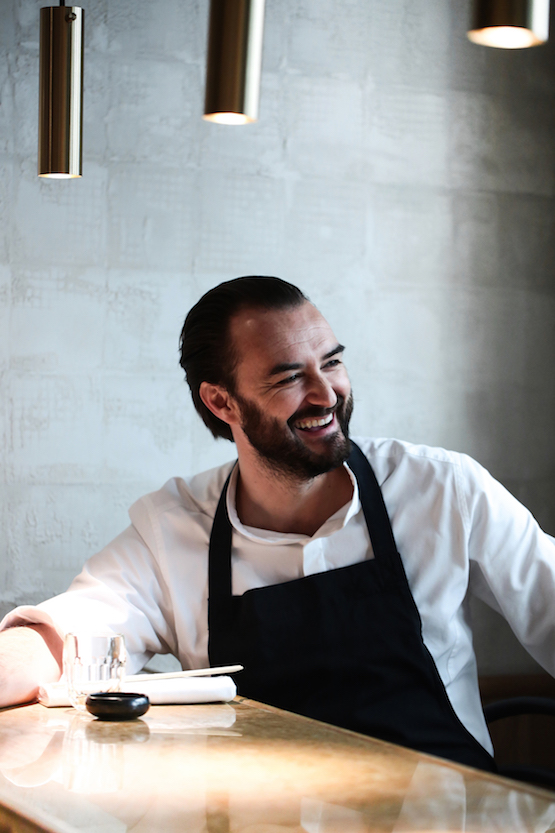 global
flavors.
global
flavors.
Le Bar des Pres is small, with a bustling bar and just a few tables along the wall. It gets a young crowd, yet, this being Paris, there is none of that ear-ringing cacophony you’d find at a comparable spot in New York City. It’s one of those places that from the street looks like the coolest place in the neighborhood, in this case on the Left Bank in the 7th Arrondissement.
The menu begins with two pages of specialty cocktails—unusual in Paris, and each only 5€ —then two more pages of regional wines, with several under 50€; then a two-page menu, skewered to Asia, especially Japan, so it begins with sashimi (an assortment is 24€; sushi, six pieces for 28€). These were certainly among the best examples of raw fish I’ve had in Paris—something I don’t usually seek out—with the same commitment to quality as in French dishes at Lignac’s other places.
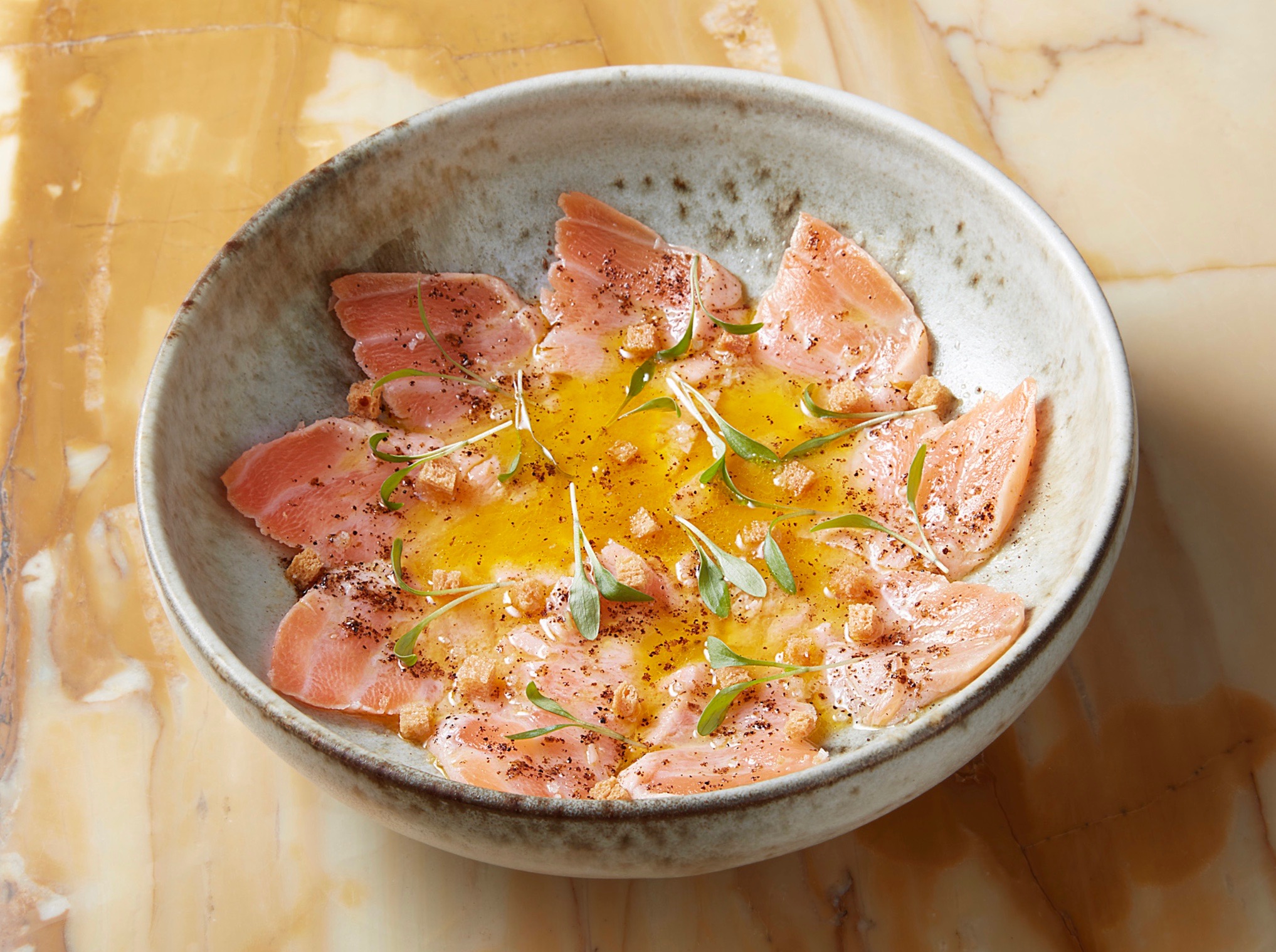 “To
Share” dishes went from a warm tomato in
vinaigrette caramelized with miso, avocado and
croutons (18€) to Brittany lobster salad with
figs, walnuts and sansho pepper (28€). Well-fatted chu-ton tuna
was semi-cooked, dashed with ponzu sauce and a
warm toasted sesame oil (20€), while a crispy
pancake contained crab in a light Madras curry
sauce with avocado and lime (22€).
“To
Share” dishes went from a warm tomato in
vinaigrette caramelized with miso, avocado and
croutons (18€) to Brittany lobster salad with
figs, walnuts and sansho pepper (28€). Well-fatted chu-ton tuna
was semi-cooked, dashed with ponzu sauce and a
warm toasted sesame oil (20€), while a crispy
pancake contained crab in a light Madras curry
sauce with avocado and lime (22€).
The flavors were tantalizing in each dish, the
colors brilliant, and the devotion to
complementary textures rife throughout. Everything
was beautifully, simply presented, the pacing of
the meal was flawless, 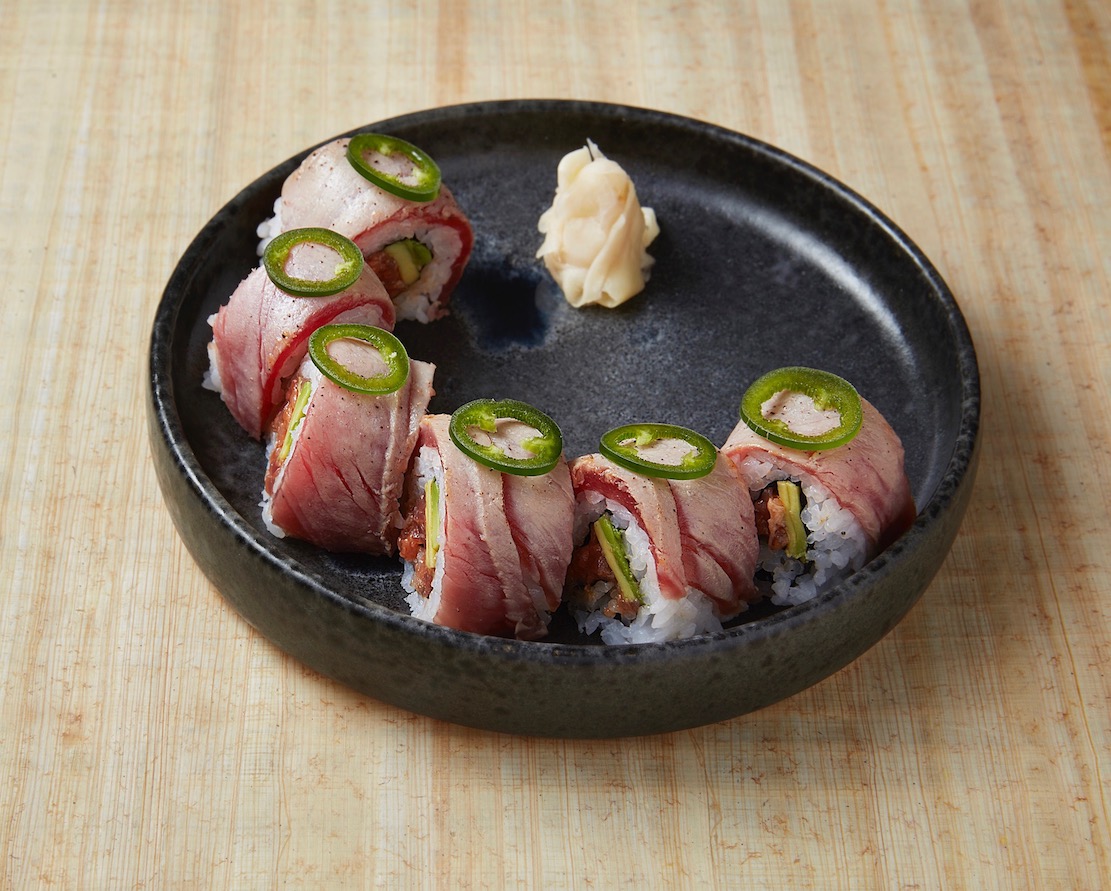 and
everyone was clearly having a very happy time of
it.
and
everyone was clearly having a very happy time of
it.
Desserts follow the same line, by taking a traditional baba au rhum and giving it a dollop of Matcha green tea ice cream (12€); fresh, perfect raspberries cuddled in whipped cream and a coconut sorbet (11€), while Japanese tapioca came in coconut milk with pineapple confit scented with vanilla (11€). For something nostalgic there is a plate of rich profiteroles with vanilla and tonka beans and caramelize hazelnuts (11€).
I don’t care a whit for what’s “hot” in any city, for it’s easy enough to tell that Le Bar des Prés is packed because people who know great sushi take every seat every night.
AU PETIT TONNEAU
20 Rue de Surcouf
+33 1-4705-0901
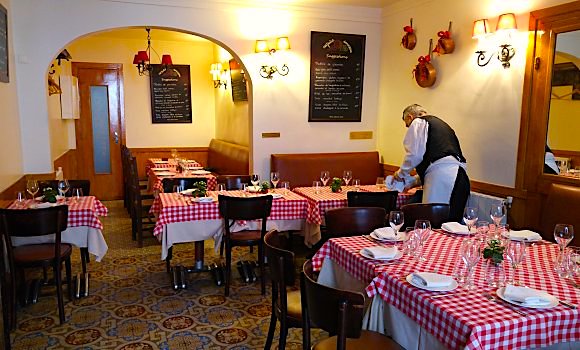 Every
Parisian has a favorite neighborhood bistro, and
in the area near Les Invalides, Au Petit Tonneau
is mine. Typical
in its simple décor—small, narrow, with
red-checkered tablecloths, vases of flowers, old
tiles, a little shelf of books, a blackboard menu,
and a jolly staff—this 80-year-old wonder makes
old-fashioned fare that never seems old-fashioned
at all. You never have the
feeling the kitchen, now under Chef Vincent Neveu,
is just coasting or neglecting any aspect
Every
Parisian has a favorite neighborhood bistro, and
in the area near Les Invalides, Au Petit Tonneau
is mine. Typical
in its simple décor—small, narrow, with
red-checkered tablecloths, vases of flowers, old
tiles, a little shelf of books, a blackboard menu,
and a jolly staff—this 80-year-old wonder makes
old-fashioned fare that never seems old-fashioned
at all. You never have the
feeling the kitchen, now under Chef Vincent Neveu,
is just coasting or neglecting any aspect 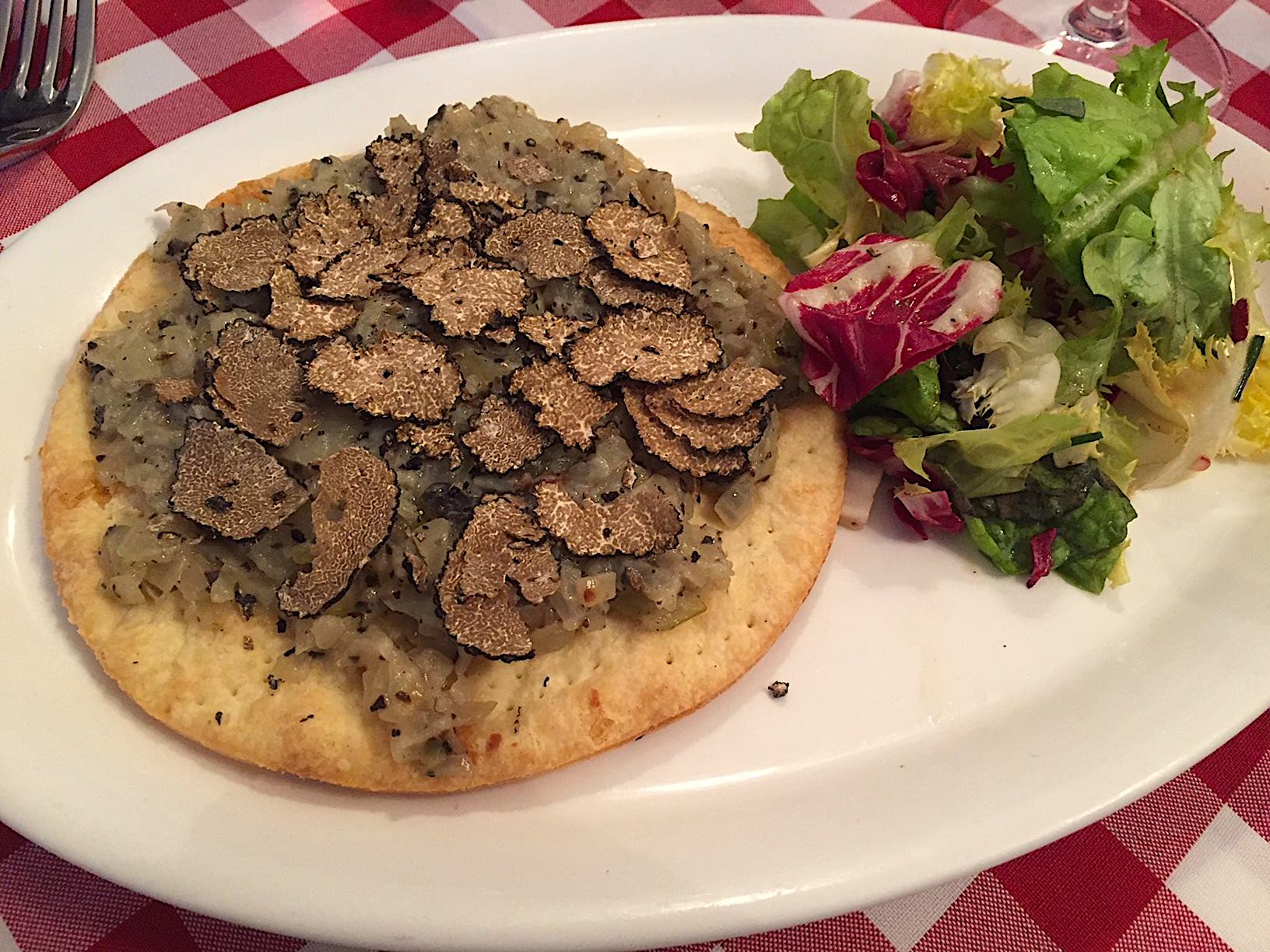 of its
ingredients or preparation, from a sweet onion
tart confit
(below)
on flakey pâte
brisée with a generous shower of black
truffles (20€) and a poêle of
woodsy girolles
mushrooms (20€) to a blanquette de veau
(24€) so rich and aromatic that I was reminded of
the first example I ever ate in Paris, fifty years
ago.
of its
ingredients or preparation, from a sweet onion
tart confit
(below)
on flakey pâte
brisée with a generous shower of black
truffles (20€) and a poêle of
woodsy girolles
mushrooms (20€) to a blanquette de veau
(24€) so rich and aromatic that I was reminded of
the first example I ever ate in Paris, fifty years
ago.
Bass came with a lovely herbaceous sauce vièrge (24€) and a hint of curry. Desserts were very traditional—a tangy lemon tarte (below) and a not-too-sweet tarte Tatin of caramelized apples.
According to Paris food writer Alexander Lobrano, “Obliged to sell by poor health, Au Petit Tonneau’s chef owner Ginette Boyer was determined to sell to a woman, because she hoped to preserve the legacy of the cuisine menagère (home cooking) that had won her a devoted following of local regulars through the years. In the end, Arlette Iga, a client of the restaurant, decided to buy, and she’s respecting Boyer’s wishes by serving the type of uber traditional French comfort food that’s become nearly extinct in Paris.”
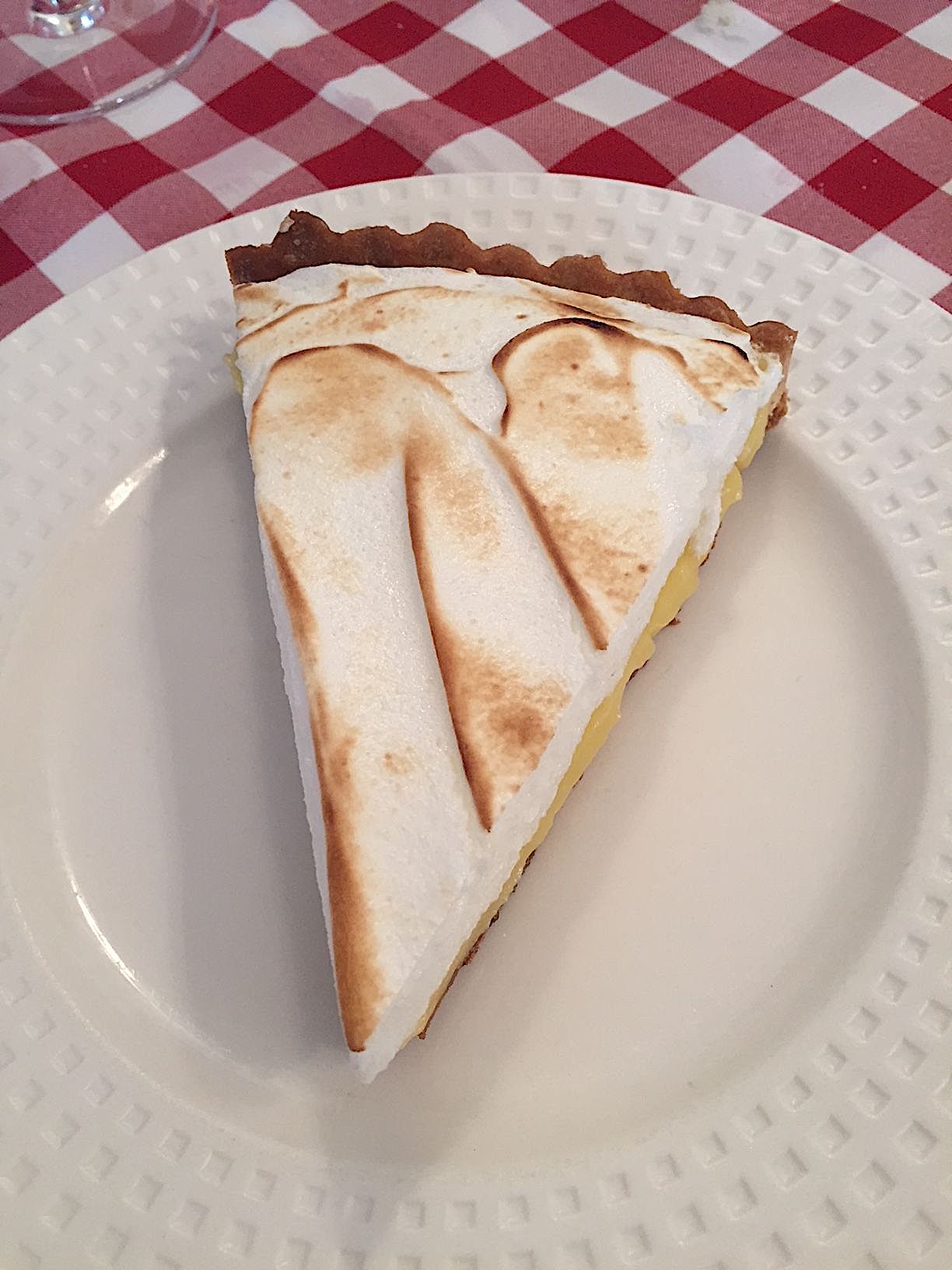 There
is
a polished brass plaque on the wall (just above
the banquette in the photo above) that tells you
Jules Maigret, the gourmand detective in many of
the Georges Simenon novels, dined here often, if
fictitiously, just as Sam Spade did at John’s
Grill in San Francisco in The Maltese
Falcon.
There
is
a polished brass plaque on the wall (just above
the banquette in the photo above) that tells you
Jules Maigret, the gourmand detective in many of
the Georges Simenon novels, dined here often, if
fictitiously, just as Sam Spade did at John’s
Grill in San Francisco in The Maltese
Falcon.
By the way, there is at least one other restaurant in Paris with the word “tonneau” (barrel) in it, but the one on the Rue de Surcouf is the only one that matters.
There is a 37€ fixed price dinner offered in addition to à la carte.
 CAMÉLIA
CAMÉLIA
Mandarin Oriental Paris Hôtel
251 Rue Saint Honoré
+33 (0) 1-7098-7400
The
Mandarin Oriental Paris near Place
Vendôme takes a very modern tack in its décor,
which gives its dining room, Camélia, a look that
might resemble the commissary on the Starship
Enterprise—white chairs on white tile floors and
white floors, white amoeba-shaped ceiling
panels, huge white flower 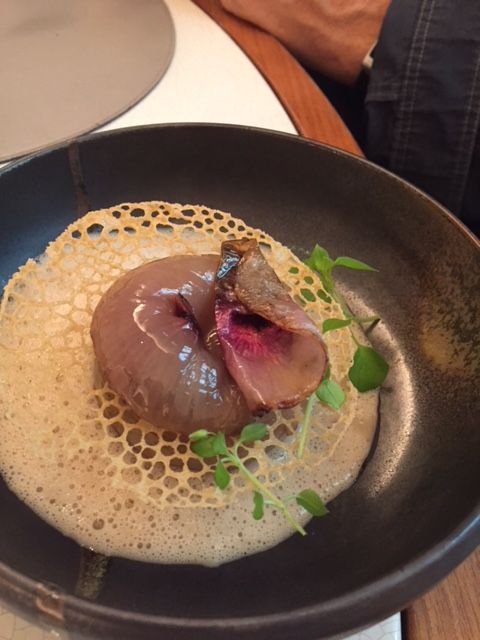 petal shapes behind the
banquettes, white flowers and recessed ceiling
lights.
petal shapes behind the
banquettes, white flowers and recessed ceiling
lights.
There
is a Japanese element to Chef Thierry Marx’s
composed dishes on rustic ceramics. Portions are
not lavish and prices high, as with “La
Saint-Jacques,” meaning one large seared scallop
with artichokes (62€). Leeks cooked in foil so as
to steam came cold atop romaine lettuce with a
truffled vinaigrette (32€), and an onion Roscoff (right) was
set into a modernist foam sauce with a duxelle of
mushrooms (29€). More substantial was
suckling pig with sesame, maki wasabi
mayonnaise (46€), and a dish of succulent
chicken with coffee-infused parsnip and honeyed
gravy (56€). The best of the desserts tried was a
gâteau St. Honoré.
There is an extensive list of
wines by the glass, starting at 13€; otherwise
bottle prices are expensive.
Camélia is the more casual restaurant at the
hotel, with Sur Mesure par Thierry Marx the
gourmet room.
In warm weather, the
garden is where you want to sit, sip some
Champagne and wile away the afternoon.
There is a 78€ "Shopping
Lunch," a tea time menu and Sunday brunch is 108€.
❖❖❖
By John Mariani
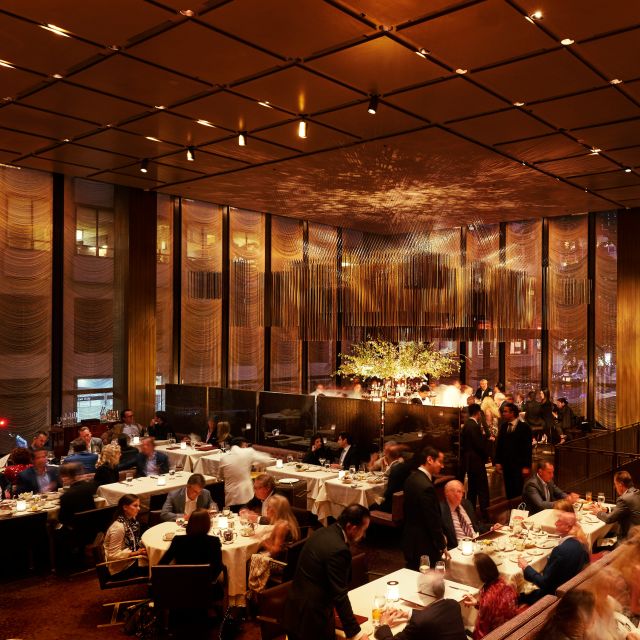 THE
GRILL
THE
GRILL99 East 52nd Street
212-375-9001
Sometimes
you can try so hard at something and still
come out looking quite inept.
So it is with The
Grill, whose unique beauty—dating back to 1959,
when it was called The Four Seasons—gained rare
landmark status, meaning the new owners could
not so much as put a tack into a wall.
Having so much grandeur to work with, the owners, along with the Major Food Group’s partner/chefs Rick Torrisi, Mario Carbone and partner Jeff Zalaznick, have pulled out all the stops in a gamble that seeks to bring back the fine dining era of the 1960s, while upgrading every item on the menu. Ironically, none of the partners was even born back then and none has any first-hand knowledge of the time. And, they have not, in any way, succeeded in replicating those days.
Lest anyone suspect my writing a social history
of The Four Seasons 20 years ago colors my
current reaction to The Grill, the former was
never among my favorite restaurants in New York
City, except for that spectacular interior and
its enormous influence on fine dining in
America. It was where the Power Lunch was
created, with every table in the Grill taken
every day at lunch by NYC’s media, show biz and
political titans. It was a place to take one’s
out-of-town friends for elegantly
presented—often tableside prepared—fare that was
always consistently good, 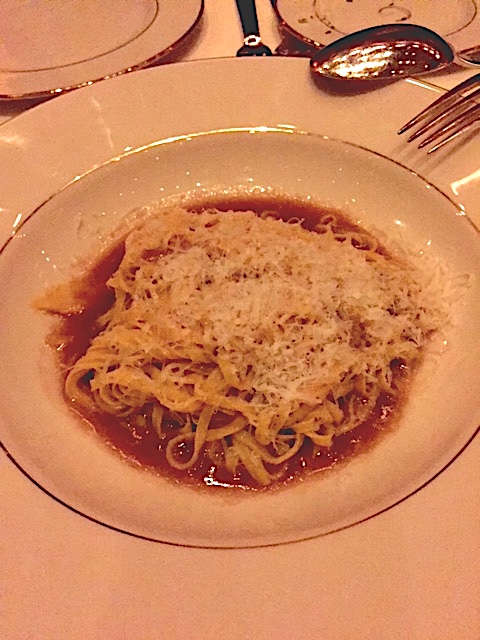 though rarely
exquisite.
And it cost a royal fortune to eat there.
though rarely
exquisite.
And it cost a royal fortune to eat there.
It still does but, as they say, you can’t eat the furniture. You can bask in the ambiance and look for celebrities, but the reason most people go to a restaurant is for the food. Little I tasted at The Grill would make me return. There is much pizzazz but not much good taste. Tableside service has returned, but it’s nothing like what you’d expect: A $10,000 silver duck press (never much used in NYC restaurants) is employed by a single server to make parts of a duck and bacon fat into a bland sauce that is poured over tagliatelle noodles to no savory effect ($29) (right). More on the roast beef rolling cart in a moment.
As you walk into the former Four Seasons restaurant—The Grill is set down a hallway from the even grander Pool Room, which I wrote about a few weeks back—you face four pleasant greeters in the white marble-clad, rather cold lobby. The host station used to be at the top of the stairs, where it makes sense. At the top of that grand staircase is a splendid bar to the right, overhung with a famous Richard Lippold sculpture of gold rods. As of 6 p.m. it gets very loud there, not helped by the intrusion of wholly unnecessary music from the Fifties and Sixties. When the bar crowd staggers out around seven, things quiet down a little. But the lighting in the dining room is much lower than it used to be, so that all hopes of spotting someone of any note is dimmed.
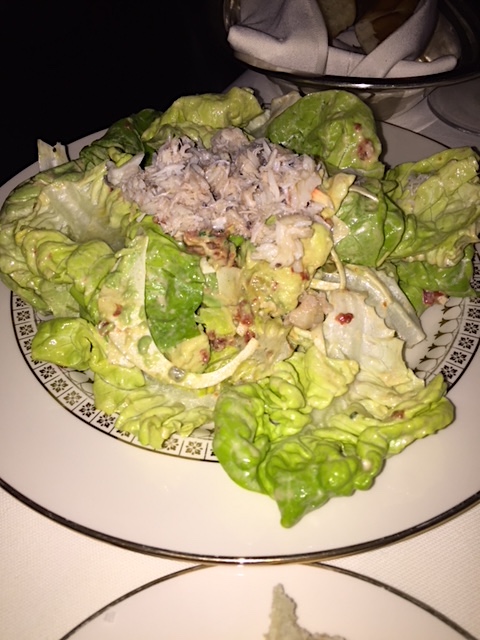 I doubt you’ll find a
better trained staff in NYC, though it’s
difficult to figure out who does what. There
seems to be no maître d’ per se, though there
are figures in Tom Ford tuxedos and others in
waiters’ or busboys’ jackets, then those two
people who run the tableside service, someone
who seems to be the sommelier, and assorted
others who rush frantically about the room. But
they are knowledgeable and gracious, happy to
discuss a menu that needs a lot of explanation. God
knows how many times a night a waiter needs to
launch into an inane story about how JFK on his
birthday at The Four Seasons was serenaded by
Marilyn Monroe but just asked for what is now
called “Jack’s Pie” on the menu. “Pheasant
Claiborne” would seem to be named after the late
NY Times
food critic Craig Claiborne, but it’s never
satisfactorily explained.
I doubt you’ll find a
better trained staff in NYC, though it’s
difficult to figure out who does what. There
seems to be no maître d’ per se, though there
are figures in Tom Ford tuxedos and others in
waiters’ or busboys’ jackets, then those two
people who run the tableside service, someone
who seems to be the sommelier, and assorted
others who rush frantically about the room. But
they are knowledgeable and gracious, happy to
discuss a menu that needs a lot of explanation. God
knows how many times a night a waiter needs to
launch into an inane story about how JFK on his
birthday at The Four Seasons was serenaded by
Marilyn Monroe but just asked for what is now
called “Jack’s Pie” on the menu. “Pheasant
Claiborne” would seem to be named after the late
NY Times
food critic Craig Claiborne, but it’s never
satisfactorily explained.
There is a chef’s buffet offered nightly and a selection of chilled crustaceans, along with items like house-cured salmon ($24), pickled sardines ($21), and crudités $23). One of the best dishes I had was the tangy cauliflower piccalilli. A wild mushroom omelet ($25) is prepared tableside, which is odd when you have a buffet cook nearby. Marvelous rolls come warm to the table but the only butter you get is compounded with ingredients.
Crab Louis ($29) is a
salad of crab and hard-boiled egg (left)
formulated on the West Coast before World
War I—Louis has never been convincingly
identified—that has acquired avocado at The
Grill and emerges looking like a ladies’
luncheon plate at a country club. A dish of
fresh, seared foie gras with onions ($32) was
very disappointing, because it was sinewy,
suggesting it might be grade B or C liver (right, shown with shared
chicken). Like most dishes at The
Grill, it was very salty, as was the Seagram
Crabcake ($36), topped with a crisp potato
layer, which at these prices should have been
composed entirely of jumbo or colossal lump
crab.
Coast before World
War I—Louis has never been convincingly
identified—that has acquired avocado at The
Grill and emerges looking like a ladies’
luncheon plate at a country club. A dish of
fresh, seared foie gras with onions ($32) was
very disappointing, because it was sinewy,
suggesting it might be grade B or C liver (right, shown with shared
chicken). Like most dishes at The
Grill, it was very salty, as was the Seagram
Crabcake ($36), topped with a crisp potato
layer, which at these prices should have been
composed entirely of jumbo or colossal lump
crab.
Triple lamb chops with curried flavors and mint jelly ($59) were fine, best enjoyed with the hash brown potatoes ($12). Bay scallops were good to find on the menu, but they were served at room temperature when a quick sauté would have improved their flavor.
As for that rolling serving cart (below),
which was once a staple of old line French
restaurants, it was good to see it back. Much
has been written about how the chefs pondered
how to improve the cooking of prime rib, which
too often emerges steamy on the plate. Their
solution was to cut off the bone, slowly
barbecue, then bring it back for service with a
slab 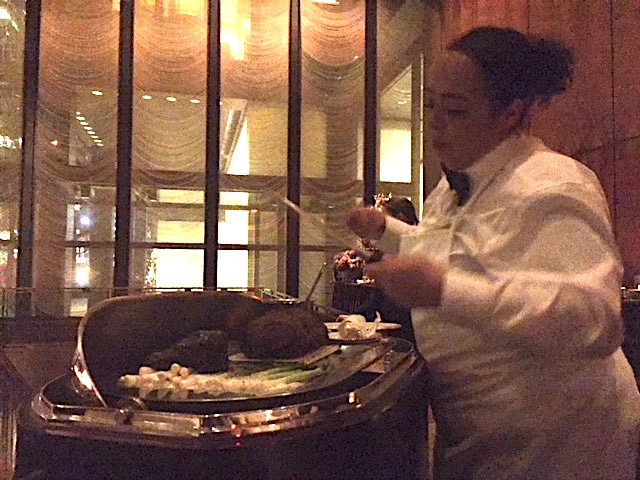 of nicely
marbled roast beef ($65)—a very good idea,
because that bone is the very best thing I had
that evening, a succulent, mustard-flavored,
crusted beauty to gnaw on. The problem is that
that crust is, yet again, powerfully salty, as
is the rim of fat around the smoky beef,
rendering it close to inedible. For
the record, no one at our table of four finished
their slice of beef, which tasted closer to
pastrami than to Prime rib (below).
of nicely
marbled roast beef ($65)—a very good idea,
because that bone is the very best thing I had
that evening, a succulent, mustard-flavored,
crusted beauty to gnaw on. The problem is that
that crust is, yet again, powerfully salty, as
is the rim of fat around the smoky beef,
rendering it close to inedible. For
the record, no one at our table of four finished
their slice of beef, which tasted closer to
pastrami than to Prime rib (below).
Possibly the most retro thing at The Grill is the desserts ($15), which might well have shown up at any continental restaurant in the U.S. back in 1965—including a way-too-sweet grasshopper Charlotte, which looks like a Carvel birthday cake and needs a stake in its heart forever.
The wine list is exemplary and wide-ranging,
though trying to find a bottle under $150 is
tough. Most cocktails are $18, oddly enough 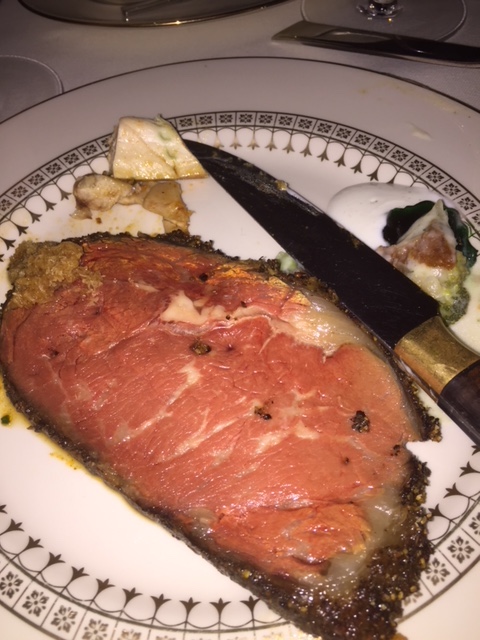 not the highest in
town. Offering
dozens of vintages of Château d'Yquem
Sauternes is very odd indeed, since so few
people ever drink Sauternes anymore.
Especially when they run several hundred
dollars a bottle.
not the highest in
town. Offering
dozens of vintages of Château d'Yquem
Sauternes is very odd indeed, since so few
people ever drink Sauternes anymore.
Especially when they run several hundred
dollars a bottle.
By the way, though not unusual these days, there is absolutely no dress code at The Grill or The Pool. In the past, The Four Seasons offered an array of blazers for gentlemen who arrived in shirtsleeves; now, in a place of such sophisticated grandeur, you may well be sitting next to a table of guys who look like they just came off the set of a Seth Rogen movie.
The Major Food Group has tried hard but has not delivered on its extravagant dream to place The Grill and The Pool among of NYC’s great restaurants. That is not entirely surprising, for Torrisi and Carbone, who have enormous chutzpah to match their considerable talent and foodie media idolatry, have never actually operated anything on this grand scale before. They began with a charmingly modest little Italian-American spot named Torrisi (now closed), then several sandwich shops called Parm, a flagrantly expensive Italian throwback called Carbone, ZZ’s clam bar, a bistro with the off-putting name Dirty French, even a Japanese brasserie named The Lobster Club. So the leap from those to remaking The Four Seasons is like the gang on Pawn Stars opening an Old Masters art gallery, or Miley Cyrus singing Carmen. Easier dreamt than done.
One last thing, if you can find the restaurant’s phone number—it’s not on its website!—212-375-9001—you’ll get the recorded voice of a woman with a curious British accent who says you cannot book a reservation by phone, only through Open Table. I’d expect that from a casino-based branch restaurant in Vegas, but not in a restaurant striving to epitomize NYC hospitality in 2017.
Open daily for lunch and dinner.
❖❖❖
MERLOT MOVES UP IN FAVOR
By Brian Freedman
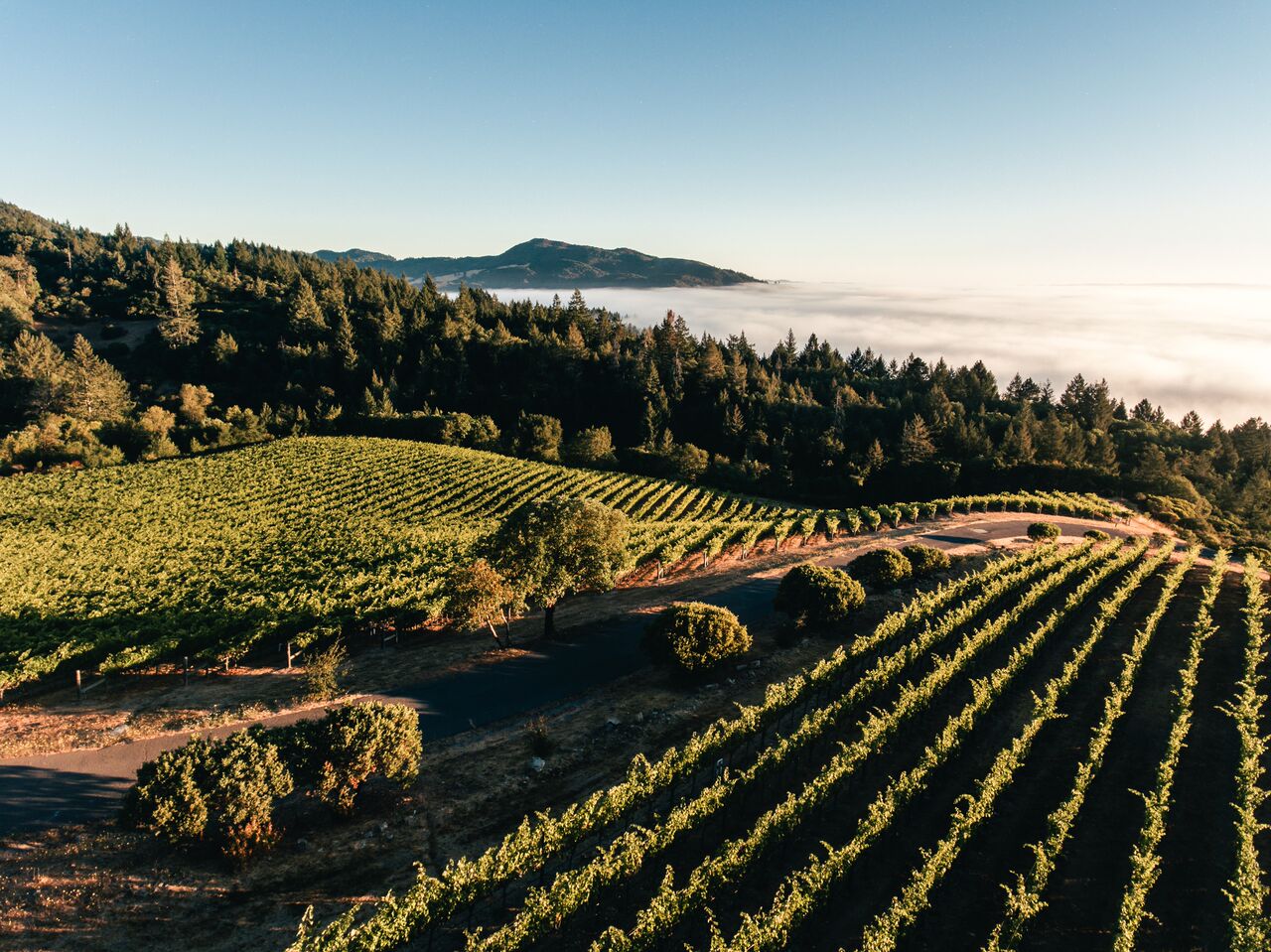
The days of
American Merlot struggling for respectability
are, thankfully, in the past.
Consumers at retail and
guests of restaurants are increasingly spending
their money on what, in the right hands in the
vineyard and winery, has the potential to be one
of America’s vinous calling cards. Just last
month, in fact, Wine
Spectator announced its Wine of the Year:
The Duckhorn Three Palms Vineyard Merlot 2013, a
glorious wine that I wish I had more than one
bottle of in my personal cellar, the better to
follow its evolution over the next several
decades.
There is, of course, no single style of American
Merlot, just as there is no quintessential
American accent, culinary tradition or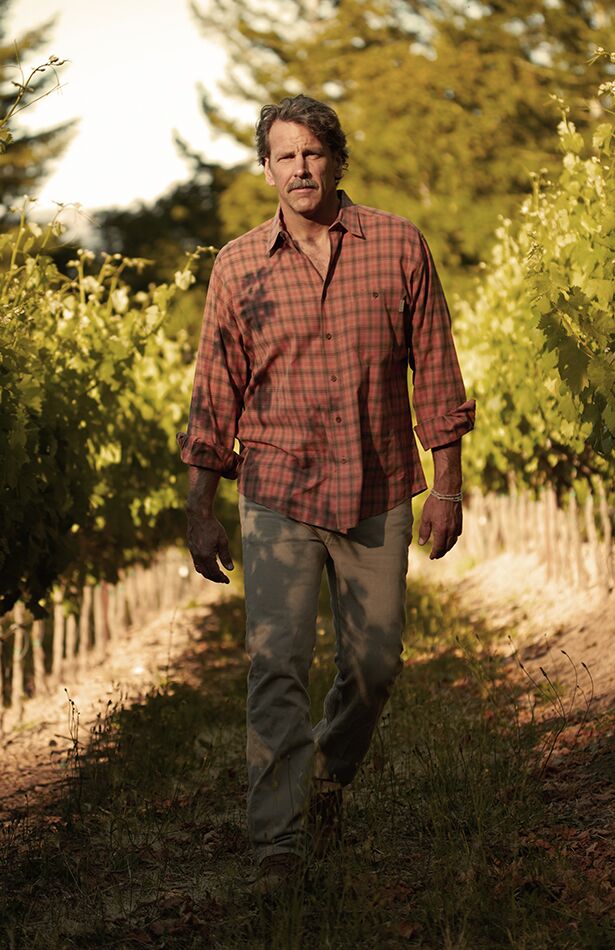 political affiliation. Indeed, even within
individual regions or appellations, the range of
styles can be tremendous, depending on drainage,
aspect, wind and what precisely happened in that
particular patch of the planet 250 million years
ago that impacts the exact nature of the soil
even today. Just tasting through the marvelous
single vineyard Merlots from Duckhorn, or
pouring the La Jota and Mt. Brave Merlots
side-by-side—both crafted by the same deeply
talented and dedicated winemaker, Chris
Carpenter (right),
from totally different terroirs—is enough to
prove that. They’re also enough to prove just
how fascinating and delicious American Merlot
can be when treated with the respect it so
richly deserves.
political affiliation. Indeed, even within
individual regions or appellations, the range of
styles can be tremendous, depending on drainage,
aspect, wind and what precisely happened in that
particular patch of the planet 250 million years
ago that impacts the exact nature of the soil
even today. Just tasting through the marvelous
single vineyard Merlots from Duckhorn, or
pouring the La Jota and Mt. Brave Merlots
side-by-side—both crafted by the same deeply
talented and dedicated winemaker, Chris
Carpenter (right),
from totally different terroirs—is enough to
prove that. They’re also enough to prove just
how fascinating and delicious American Merlot
can be when treated with the respect it so
richly deserves.
For all of this range of American Merlot possibilities, however, I have found that the best of them typically boast generous fruit, a hint of herb or tobacco in the background, and a sense of structure that, while perhaps less monumental in general than the top Napa Cabernets, still provides the scaffolding for the best of them to age for many years—and sometimes decades—in the cellar in top vintages.
As these wines continue to gain traction, consumers should expect them to keep getting better for reasons of simple economics: As the wines improve, and as their reputations (and therefore prices) continue to catch up with their already high quality, better and better land will be given over to Merlot, which will increase quality even further, inflate prices higher, increase American Merlot prestige, and on and on the positive feedback loop will spin.
Right now, however, there is no shortage of world-class Merlot being produced all over the United States, and often at prices that, given the pleasure they offer now as well as their potential longevity, are beyond fair. Here are seven of my favorites, listed alphabetically, either varietally-labeled Merlot or blends based on the grape. Any one of them would be a more than welcome addition to the cellar or the dinner table, during the holiday season and well beyond.
Broadside Merlot Margarita Vineyard 2013 Paso Robles ($13).
Lush and perfumed nose, with spice, sandalwood, and a hint of incense, turning to flavors of kirsch, cassis, chocolate, and espresso. Drink now to 2022.
Dolin Malibu Estate Vineyards “The Blue Note” 2012 Malibu Coast ($45).
A blend of 44% Merlot, 36% Cabernet Sauvignon and 20% Cabernet Franc. Gobs of crème de cassis and kirsch define the liqueur-like nose. The palate boasts sweet fruit that remains in balance, with fig pudding, game-meat carpaccio, and a hint of flowers on the finish. Excellent with slow-braised meats this winter. Drink now to 2021.
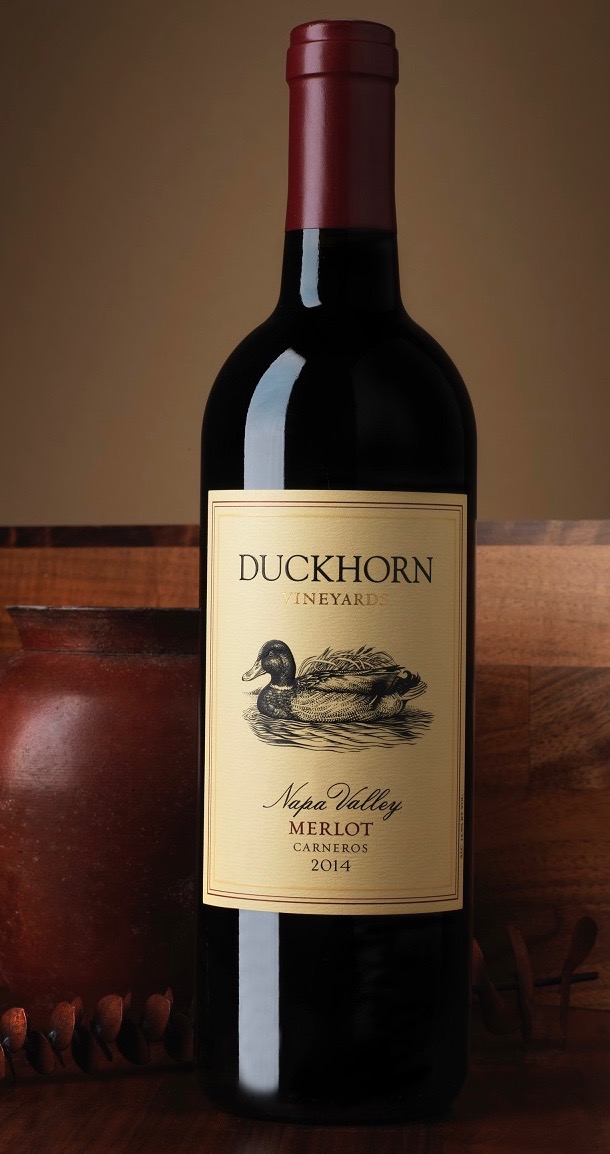 Duckhorn
Vineyards Napa Valley Merlot 2014 Carneros ($37).
Duckhorn
Vineyards Napa Valley Merlot 2014 Carneros ($37).
Serious Merlot, with a tar-like edge of aromatic savoriness to the black cherry, cherry liqueur, and vanilla pod. On the palate, this is plush and giving, with chocolate, black cherries enrobed in ganache, a hint of coffee, and violets, especially on the finish. Drink now to 2024+.
La Jota Vineyard Co. Merlot 2014 Howell Mountain ($84).
Brilliant, generous nose of wild strawberry, dark berries, and sweet oak spice, and a palate that is still in its youth, yet already showing cherry, flowers, and vanilla crème brûlée, all framed with the minerality you’d expect from such high-quality mountain fruit. The structure and long, balanced finish promise a decade and a half of evolution. Drink now to 2033.
Mt. Brave Merlot 2014 Mt. Veeder ($85).
An entire field of
mountain berries is zipped through with mineral
on the nose, and there is a hint of Chinese five
spice peeking through it all. On the palate,
this is impeccably structured and defined by its
minerality, as well as currant, mulberry,
cherry, plum pit, and spice, electrified with
excellent acidity. Fantastic now with a stint in
the decanter, but I’d hold onto it for a few
more years. Drink 2020 to 2042.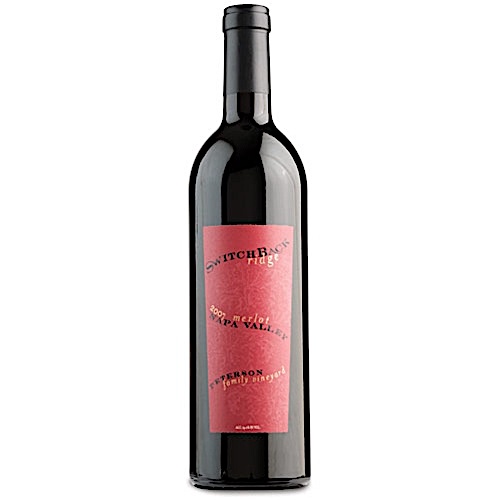
Stinson Vineyards Meritage 2014 Monticello ($32). A blend of 46% Merlot, 20% Cabernet Sauvignon, 12% Cabernet Franc and 12% Petit Verdot. Lots of red cherry and fresh raspberry on the nose, with a touch of well-integrated oak, and a silky palate of fruit and spice, more of that cherry, and a bit of tobacco-flecked vanilla. The finish is more savory than expected, and complicated by a delicious licorice note. Drink now to 2022+.
Switchback Ridge Peterson Family Vineyard Merlot 2012 Napa Valley ($55).
This has started down the road toward maturity with a real sense of elegance, the aromas of sweet exotic spice and cigar humidor, as well as dried figs and plums, all turn to a palate sweetly fruited and generous, with roasting coffee beans, dark and dusty chocolate, a hint of wild strawberries and dark cherries, cinnamon, and a touch of clove. Drink now to 2022.
❖❖❖

THINGS HIGHLY IMPROBABLE THAT
PEOPLE WOULD TAKE FROM A COFFIN
Before passing away at the age of 75, Richard Lussi of
Philadelphia asked to be buried with two
OOPS! VEDDY VEDDY BAD!

A Pakistan woman named Aasia Bibi (not the woman in
the photo) forced to marry a man against her will tried
to escape her fate by poisoning her new husband, but
instead accidentally caused the deaths of 16 other
people. Apparently a few days before the wedding, Bibi
allegedly poisoned a glass of milk intended for her
husband, but it was instead used by his mother to make
yogurt lassi for 27 members of their extended
family. Seventeen people have died so far. Bibi
and her boyfriend were arrested on murder charges. Bibi
told the court that her husband had been her only
target, and she regretted the deaths of the other
guests.
Wine
Column Sponsored by Banfi Vintners
SANGIOVESE HOLIDAYS
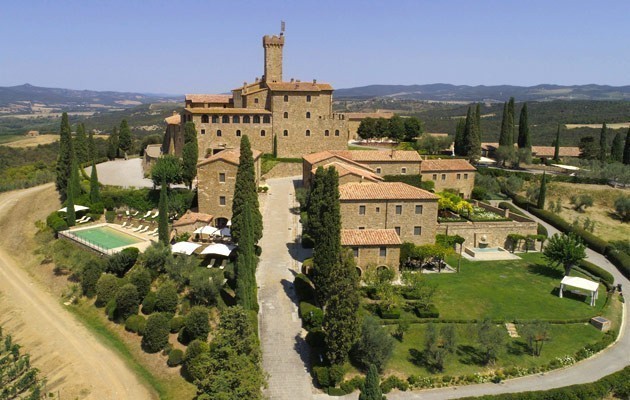 Wine
is a joy year-round but around the holidays
in particular, one grape varietal
has really taken center stage in my daily
activities – that most Italian of grapes,
Sangiovese, and its ultimate expression – Brunello
di Montalcino.
Wine
is a joy year-round but around the holidays
in particular, one grape varietal
has really taken center stage in my daily
activities – that most Italian of grapes,
Sangiovese, and its ultimate expression – Brunello
di Montalcino.
From mid-September through mid-October, the
Sangiovese grown for our various styles of red wines
are be harvested, culminating with the top selection
for Brunello di Montalcino.
Second, cooler
weather here means it is time to start enjoying more
red wines and especially Sangiovese based wines. That
includes Banfi’s cru of Brunello, Poggio alle Mura,
literally the cream of the crop of our Sangiovese
vineyards. Alongside our Poggio alle Mura Brunello
di Montalcino, this year we introduced two more
wines from the cru Poggio alle Mura – a Rosso di
Montalcino and a Riserva of Brunello. Rosso is
sort of like the younger brother of Brunello, also
made from 100% Sangiovese grapes but usually a
selection from younger vines and the wine is aged
only two years compared to the four required for
Brunello. The
Riserva, on the other hand, is an even more
selective harvest of Sangiovese, and ages for an
additional year before release.
What is so special
about this cru Poggio alle Mura? Well, it
is the result our over 30 years of ongoing research
at my family’s vineyard estate, Castello Banfi. When we
first began planting our vines there in the late
1970s studies from the University of Bordeaux
indicated which strains of many varietals we should
plant, based on the soil type and microclimate of
each vineyard.
But when it came to the region’s native
Sangiovese, there was only local lore, no scientific
research. So
we took it upon ourselves to figure out this vine,
and set off on three  decades of
incredibly detailed research.
decades of
incredibly detailed research.
We started with 600
apparent variations on Sangiovese, because it is so
susceptible to variations in weather and soil, and
narrowed that down to 160 truly genetically
different clones.
We planted a vineyard with two rows of each
type, made wine from each of them, and charted the
differences – remember, you only get one chance a
year to make wine, so this took time.
It took about ten
years to get some concrete results, though we
continue to experiment today and always will – you
never stop learning in science and nature! Once we
determined which were the best, complementary clones
that could be planted together to make the best
Brunello, we chose to plant them in what we
determined to be the optimal vineyard sites. Coincidentally,
the best soils and climate conditions are in the
slopes surrounding the medieval fortress today known
as Castello Banfi, known since Etruscan times as
Poggio alle Mura – the walled hilltop. Hence the
name of our most special “cru” of Brunello,
representing a synthesis between tradition and
innovation.
Though the focus of
this study was our Brunello, all of our
Sangiovese-based wines, including the super Tuscans
SummuS, Cum Laude, and Centine, benefited from this
work. And
that’s the third reason for celebrating Sangiovese
this month, for the range of wonderful reds that
usher us into autumn!
One wine in particular was inspired by our
research – the BelnerO, a Sangiovese dominant blend
with what I like to call a kiss of Cabernet and a
whisper of Merlot.
We grow the grapes a little differently for
BelnerO than for Brunello, make the wine with less
oak aging and released it earlier from the winery,
providing a counterpoint to Brunello and a lovely
terroir-driven wine in its own right.
If you
know Italians, you know that by nature we are
multi-faceted, varying in mood, and always
passionate. As
a nation, we span from the hot sunny beaches of
Sicily near the African coast to the rugged
mountains and Alpine ski slopes of Trentino-Alto
Adige in the north.
Sangiovese is grown in almost all of Italy’s
regions and reflects the unique nature of each; it
is most famous (rightfully so) in Tuscany, yet even
there it reflects the nuances of each hilltop,
valley and subzone.
It has something a little different to say in
Brunello than Chianti, Morellino than Vino Nobile di
Montepulciano, Rosso di Montalcino than Super Tuscan
blends.
Here is a smattering
of Sangiovese-based wines that you may wish to get
to know better, reflecting a spectrum that appeals
to every occasion, every taste, and every budget. We can
assure you that the conversation will never become
boring.
Recommendations for Celebrating
Sangiovese
BelnerO Proprietor’s Reserve
Sangiovese – A refined
cuvée of noble red grapes perfected by our
pioneering clonal research. This dark beauty,
BelnerO, is produced at our innovative winery,
chosen 11 consecutive years as Italy’s Premier
Vineyard Estate. Fermented in our patented
temperature controlled French oak and aged
approximately 2 additional years. Unfiltered, and
Nitrogen bottled to minimize sulfites.

Castello Banfi Brunello di
Montalcino – Rich, round, velvety and intensely
aromatic, with flavor hints of licorice, cherry, and
spices. Brunello di Montalcino possesses an intense
ruby-red color, and a depth, complexity and opulence
that is softened by an elegant, lingering
aftertaste. Unfiltered after 1998 vintage.
Castello Banfi Rosso di
Montalcino – Brunello's "younger brother," produced
from select Sangiovese grapes and aged in barrique
for 10 to 12 months. Deep ruby-red, elegant,
vibrant, well-balanced and stylish with a dry
velvety finish.
Poggio all’Oro Brunello di
Montalcino Riserva – A single vineyard selection of our most
historically outstanding Sangiovese, aged five years
before release, the additional year more than that
required of Brunello including 6 months in barrel
and 6 months more in bottle to grant its “Riserva”
designation. Incredible
elegance and harmony. Intense with lots of fruit and
subtle wood influence. Round, complete, well
balanced with hints of chocolate and berries.
Unfiltered after 1998.
Poggio alle Mura – The first tangible result of years of
intensive clonal research on Montalcino’s native
Sangiovese grape.
Estate bottled from the splendidly sun
drenched vineyards surrounding the medieval Castello
from which it takes its name. The Brunello di
Montalcino is seductive, silky and smoky. Deep ruby
in color with an expressive bouquet of violets,
fruits and berries as well as cigar box, cedar and
exotic spices. The Rosso di
Montalcino is also intense ruby red. The
bouquet is fresh and fruity with typical varietal
notes of cherry and blackberry, enriched by more
complex hints of licorice, tobacco and hazelnut. It is
full bodied, yet with a soft structure, and a
surprisingly long finish. The Poggio alle
Mura Brunello di Montalcino Riserva is deep
ruby red with garnet reflections and a rich, ample
bouquet that hints of prune jam, coffee, cacao and a
light balsamic note.
It is full and powerful, with ripe and gentle
tannins that make it velvety and harmonious; this
wine is supported by a pleasing minerality that to
me speaks soundly of that special hillside in
southern Montalcino.
SummuS – A wine of towering elegance, SummuS is
an extraordinary blend of Sangiovese which
contributes body; Cabernet Sauvignon for fruit and
structure; and Syrah for elegance, character and a
fruity bouquet.
An elegant, complex and harmonious red
wine.
Cum Laude – A complex and elegant red which
graduated “With Honors,” characterized by aromas of
juicy berries and fresh spices.
Centine – A Cuvee that is more than half
Sangiovese, the balanced consisting of equal parts
of Cabernet Sauvignon and Merlot. Vinified
in a firm, round style that easily accompanies a
wide range of dishes, this is a smooth and
fragrantly satisfying wine with international
character, and a perennial favorite at my own dinner
table.
Banfi Chianti Superiore – The “Superiore” designation signifies
stricter government regulations regarding production
and aging requirements, as compared to regular
Chianti. An
intense ruby red wine with fruit forward aromas and
floral notes.
This is a round wine with well-balanced
acidity and fruit.
Banfi Chianti Classico – An enduring classic: alluring
bouquet of black fruit and violets; rich flavors of
cherry and leather; supple tannins and good acidity
for dining.
Banfi Chianti Classico Riserva –
Produced from select grapes grown
in the "Classico" region of Chianti, this dry,
fruity and well-balanced red has a full bouquet
reminiscent of violets.
Fonte alla Selva Chianti Classico
– This is our newest entry into the
Chianti arena, coming from a 99 acre estate in
Castellina, the heart of the Chianti Classico
region. The
wine is a captivating mauve red that smells of
cherry, plum and blackberry with hints of spice. It is
round, full and balanced with very good
acidity.
Col di Sasso – Sangiovese and Cabernet Sauvignon. Luscious,
complex and soft with persistent notes of fruit and
great Italian style structure.
Any of John Mariani's books below may be ordered from amazon.com.
 The Hound in Heaven
(21st Century Lion Books) is a novella, and
for anyone who loves dogs, Christmas, romance,
inspiration, even the supernatural, I hope you'll find
this to be a treasured favorite. The story
concerns how, after a New England teacher, his wife and
their two daughters adopt a stray puppy found in their
barn in northern Maine, their lives seem full of promise.
But when tragedy strikes, their wonderful dog Lazarus and
the spirit of Christmas are the only things that may bring
his master back from the edge of despair.
The Hound in Heaven
(21st Century Lion Books) is a novella, and
for anyone who loves dogs, Christmas, romance,
inspiration, even the supernatural, I hope you'll find
this to be a treasured favorite. The story
concerns how, after a New England teacher, his wife and
their two daughters adopt a stray puppy found in their
barn in northern Maine, their lives seem full of promise.
But when tragedy strikes, their wonderful dog Lazarus and
the spirit of Christmas are the only things that may bring
his master back from the edge of despair. WATCH THE VIDEO!
“What a huge surprise turn this story took! I was completely stunned! I truly enjoyed this book and its message.” – Actress Ali MacGraw
“He had me at Page One. The amount of heart, human insight, soul searching, and deft literary strength that John Mariani pours into this airtight novella is vertigo-inducing. Perhaps ‘wow’ would be the best comment.” – James Dalessandro, author of Bohemian Heart and 1906.
“John Mariani’s Hound in Heaven starts with a well-painted portrayal of an American family, along with the requisite dog. A surprise event flips the action of the novel and captures us for a voyage leading to a hopeful and heart-warming message. A page turning, one sitting read, it’s the perfect antidote for the winter and promotion of holiday celebration.” – Ann Pearlman, author of The Christmas Cookie Club and A Gift for my Sister.
“John Mariani’s concise, achingly beautiful novella pulls a literary rabbit out of a hat – a mash-up of the cosmic and the intimate, the tragic and the heart-warming – a Christmas tale for all ages, and all faiths. Read it to your children, read it to yourself… but read it. Early and often. Highly recommended.” – Jay Bonansinga, New York Times bestselling author of Pinkerton’s War, The Sinking of The Eastland, and The Walking Dead: The Road To Woodbury.
“Amazing things happen when you open your heart to an animal. The Hound in Heaven delivers a powerful story of healing that is forged in the spiritual relationship between a man and his best friend. The book brings a message of hope that can enrich our images of family, love, and loss.” – Dr. Barbara Royal, author of The Royal Treatment.
 |
The Encyclopedia of American Food and Drink by John F. Mariani (Bloomsbury USA, $35) Modesty forbids me to praise my own new book, but let me proudly say that it is an extensive revision of the 4th edition that appeared more than a decade ago, before locavores, molecular cuisine, modernist cuisine, the Food Network and so much more, now included. Word origins have been completely updated, as have per capita consumption and production stats. Most important, for the first time since publication in the 1980s, the book includes more than 100 biographies of Americans who have changed the way we cook, eat and drink -- from Fannie Farmer and Julia Child to Robert Mondavi and Thomas Keller. "This book is amazing! It has entries for everything from `abalone' to `zwieback,' plus more than 500 recipes for classic American dishes and drinks."--Devra First, The Boston Globe. "Much needed in any kitchen library."--Bon Appetit. |
"Eating Italian will never be the same after reading John Mariani's entertaining and savory gastronomical history of the cuisine of Italy and how it won over appetites worldwide. . . . This book is such a tasteful narrative that it will literally make you hungry for Italian food and arouse your appetite for gastronomical history."--Don Oldenburg, USA Today. "Italian
restaurants--some good, some glitzy--far
outnumber their French rivals. Many of
these establishments are zestfully described
in How Italian Food Conquered the World, an
entertaining and fact-filled chronicle by
food-and-wine correspondent John F.
Mariani."--Aram Bakshian Jr., Wall Street
Journal.
"Equal parts
history, sociology, gastronomy, and just
plain fun, How Italian Food Conquered the
World tells the captivating and delicious
story of the (let's face it) everybody's
favorite cuisine with clarity, verve and
more than one surprise."--Colman Andrews,
editorial director of The Daily
Meal.com. "A fantastic and fascinating
read, covering everything from the influence
of Venice's spice trade to the impact of
Italian immigrants in America and the
evolution of alta cucina. This book will
serve as a terrific resource to anyone
interested in the real story of Italian
food."--Mary Ann Esposito, host of PBS-TV's
Ciao
Italia. "John Mariani has written the
definitive history of how Italians won their
way into our hearts, minds, and
stomachs. It's a story of pleasure over
pomp and taste over technique."--Danny Meyer,
owner of NYC restaurants Union Square
Cafe, The Modern, and Maialino.
|
 |
 |
 |
 |
 |
 |
 |
 |
 Everett Potter's Travel Report:
Everett Potter's Travel Report: 
 Eating Las Vegas
JOHN CURTAS has been covering the Las Vegas
food and restaurant scene since 1995. He is
the co-author of EATING LAS VEGAS – The 50
Essential Restaurants (as well as
the author of the Eating Las Vegas web site: www.eatinglasvegas.
He can also be seen every Friday morning as
the “resident foodie” for Wake Up With the
Wagners on KSNV TV (NBC) Channel 3 in
Las Vegas.
Eating Las Vegas
JOHN CURTAS has been covering the Las Vegas
food and restaurant scene since 1995. He is
the co-author of EATING LAS VEGAS – The 50
Essential Restaurants (as well as
the author of the Eating Las Vegas web site: www.eatinglasvegas.
He can also be seen every Friday morning as
the “resident foodie” for Wake Up With the
Wagners on KSNV TV (NBC) Channel 3 in
Las Vegas.

MARIANI'S VIRTUAL GOURMET
NEWSLETTER is published weekly. Editor/Publisher: John
Mariani.
Editor: Walter Bagley. Contributing Writers: Christopher Mariani,
Robert Mariani, Misha Mariani, John A. Curtas, Geoff Kalish, Mort
Hochstein, and
Brian Freedman. Contributing Photographer: Galina
Dargery. Technical Advisor: Gerry McLoughlin.
To un-subscribe from this newsletter,click here.
© copyright John Mariani 2017

